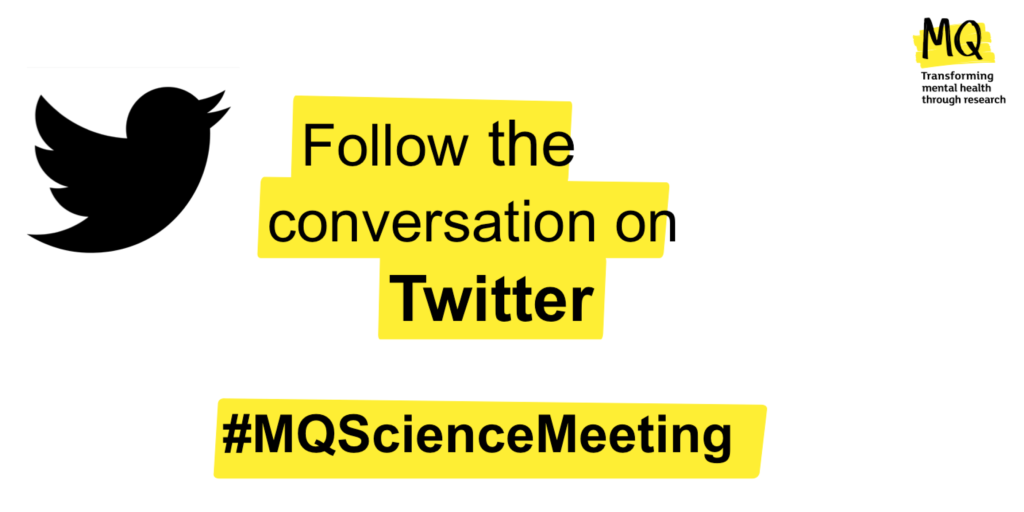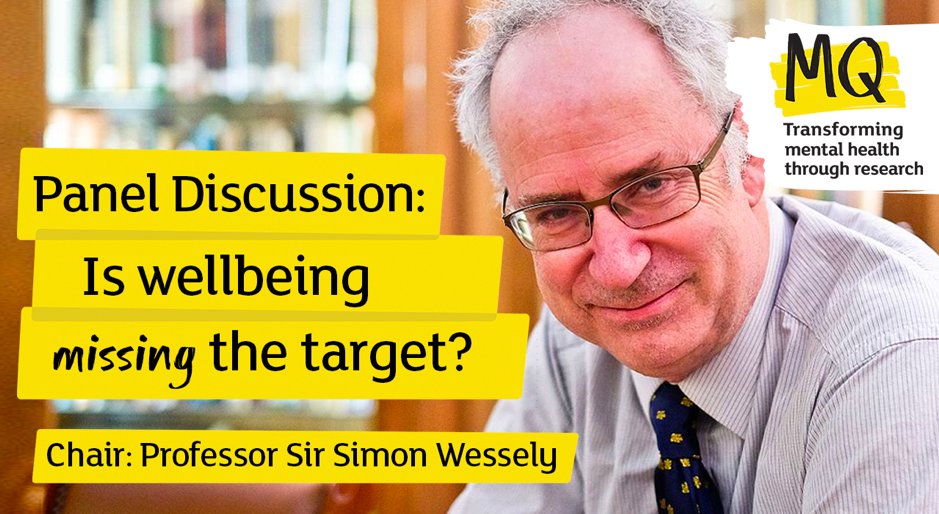
I’m at the Barbican today for the annual #MQScienceMeeting, which brings together researchers from pretty diverse backgrounds to explore how best to prevent and treat mental illness (check out the full conference programme). I’ll be live tweeting so please do join the discussion on Twitter at #MQScienceMeeting. We want as many different voices in the conversation as possible. We had a huge impact with our #BeyondTheRoom service at the conference last year and it would be great if this year could be even better.
Topics covered at the conference this year include “Pathways to health and disease”, “Development and support of the social self” and “Mechanisms of vulnerability and treatment”. A key focus in the agenda will be “The case and challenges for early intervention and prevention” and we’ll have talks from Eamon McCrory, Paul Ramchandani, Camillia Kong and Celso Arango, followed by a live streamed panel discussion (“Is wellbeing missing the target?”) chaired by Simon Wessely and featuring Martin Knapp, Ilina Singh, Karina Chopra and Catherine Newsome.
The tweeps at MQ have asked me to set the scene for the above discussion by publishing a summary of the evidence I’ve blogged in recent years relating to prevention and early intervention in youth mental illness. Never one to shirk the responsibility to close the gap between research and practice, here goes!

Follow #MQScienceMeeting on Twitter for conversations about the latest cutting edge science.
Prevention of mental illness in young people
Let’s start with a bit of scene-setting for those of you who are not in-the-know when it comes to prevention jargon. Broadly speaking there are four levels of prevention:
- Primordial prevention: prevention of risk factors themselves, beginning with change in social and environmental conditions in which these factors are observed to develop, and continuing for high risk children, adolescents and young adults.
- Primary prevention: using upstream approaches to stop mental illness from happening in the first place.
- Secondary prevention: making early intervention services available so that we can respond quickly to the early signs of mental illness and stop problems from developing into serious and long-term mental health conditions.
- Tertiary prevention: helping people who have established mental health problems and giving them the best early chance of sustainable recovery, thereby reducing the social, economic and health costs associated with mental ill-health.
Prevention programmes usually have a particular focus and these can be divided into three main types:
- Universal prevention: broad programmes that aim to influence the whole population or groups within settings such as schools, universities or workplaces.
- Selective prevention: more focused programmes that aim to reach individuals or subgroups who we know are at higher risk of developing a mental illness. These include people who are homeless, BME communities, people with learning disabilities, LGBTQ people.
- Targeted prevention: aimed specifically at people with the highest risk of mental illness, health problems and potentially showing early indications such as employees who are displaying signs of workplace stress, children whose parents have a serious mental health problem.
The #MQScienceMeeting panel discussion will focus on whether universal prevention and the drive towards mental wellbeing for all is being delivered at the expense of more targeted prevention programmes for people with more severe and enduring mental illness who really need help. I for one am really looking forward to seeing what they conclude and how future policy develops in this area.

Simon Wessely, Martin Knapp, Karina Chopra, Catherine Newsome and Ilina Singh will debate this question at 3.30pm on Friday 2nd Feb 2018.
The evidence for prevention and early intervention in youth mental illness
Over the last 3 years we have published 40 blogs that summarise important new evidence in this field. All of the blogs are written by experts who comment on the strengths and limitations of the research and go on to talk about the implications for practice, policy and future research. I’ve organised these blogs into subject areas below and I’m keen to hear from any readers who know of important evidence that we’ve not covered.
Depression and Anxiety
The dark side of universal prevention: Limited effectiveness and harmful effects of classroom-based CBT in preventing adolescent depression.
Ioana Cristea blogged about a cluster RCT by Stallard et al, which highlighted some important messages about universal prevention: Despite the use of a program previously shown as efficacious, adapted for the UK context and refined in an extensive pilot study, this large trial found limited effects for classroom-based CBT on outcomes both in the high risk group and in all participants. Moreover, along with some beneficial effects of the CBT programme, results also indicated consistent harmful effects for some outcomes. Cost-effectiveness analysis did in no way support the case for recommending classroom-based CBT as a cost-effective way of reducing depression in adolescents.
Cochrane find insufficient evidence to support the implementation of depression prevention programmes.
Ioana Cristea followed this up when she blogged about a Cochrane review by Hetrick et al and concluded that: Interventions to prevent depression in children and adolescents have a small effect in reducing the risk of obtaining a diagnosis of depression until up to 12 months following the intervention, but not beyond that. The evidence is insufficient to support the implementation of depression prevention programmes in this population.
Cognitive behavioural prevention of depression in adolescents.
Emily Stapley summarised the 6-year follow-up of the POD (Prevention of Depression) trial (presented by Prof Judy Garber at the MQ Science Meeting), which evaluated the efficacy of a Cognitive Behavioural programme involving group psychoeducation, with a focus on the development of skills in cognitive restructuring and problem-solving. The effect of Cognitive Behavioural Prevention on new onsets of depression was strongest after 9 months. This research suggests that treating parental depression may be an essential component of caring for young people who are also depressed.
Can gamified cCBT prevent depression in secondary school students?
Lisa Burscheidt summarised this school-based RCT of an online gamified cCBT intervention (SPARX-R) for preventing depression in final year secondary school students in Australia. This trial suggests that an online intervention delivered in advance of a stressful experience (in this case final-year secondary school exams in Australia) can help to prevent or minimise depression.
Targeting unhelpful repetitive negative thinking in young people to prevent anxiety and depression.
Michelle Moulds was impressed by this RCT on the prevention of anxiety disorders and depression, which found significant reductions in repetitive negative thinking (RNT), depression and anxiety in both face-to-face and guided Internet interventions. She concluded that these findings show promise for the value of prevention interventions that target problematic transdiagnostic processes such as RNT that place individuals at risk of developing psychological disorders.
Systematic review identifies key parenting factors associated with adolescent depression and anxiety.
Nikki Newhouse reminded us that there’s very little good quality evidence for the authoritarian parenting style that remains popular in prevention guidance. She concluded that Yap et al.’s Delphi study takes the macro-level synthesis of the systematic review out into the field and offers parents a coherent, evidence-based toolkit to work with.
Preventing anxiety disorders in young people at risk.
Belinda Platt reported on a systematic review that highlights promising effects for a CBT-based intervention for children of parents with an anxiety disorder. She concluded in a measured fashion: Although we know rather a lot about the risk factors for anxiety disorders in children and adolescents, this review demonstrates that we know relatively little about how to prevent the onset of anxiety in at-risk individuals. As a researcher, this review tells me that it’s far too soon to be advocating the implementation of psychological interventions for the prevention of youth anxiety. Promising interventions require replication and evaluation in the long-term.

The evidence is insufficient to support the implementation of depression prevention programmes in young people.
Early intervention in psychosis
Can social recovery therapy improve social functioning in psychosis?
Lisa Wood wrote about the SUPEREDEN3 trial, which found that in the short-term, social recovery CBT led to more structured activity and time in employment, but these gains were not maintained at follow-up. Lisa felt that this study provides some evidence for focusing on social recovery in people receiving care from early intervention services. It shows that people experiencing psychosis who also struggle with social functioning can and are willing to engage in a therapy that aims to improve their activity levels. It also demonstrates that social recovery is an important issue that participants wanted to talk about and focus on in therapy.
How does age at onset affect outcomes in schizophrenia?
Geoff Davies told us about a systematic review which confirmed that there is a small, statistically significant association between younger age of onset and worse outcomes in schizophrenia. Earlier onset of psychosis may disrupt social and cognitive development at a critical stage, but Geoff felt that the issue of patient reported outcomes should have been raised by the reviewers.
One psychosis fits all? What do families and clients say about caregiver interventions?
Laoise Renwick reminded us that NICE recommends caregiver interventions for families affected by psychosis, but this support reaches less than 1 in 3. Providing an intervention with a known mechanism of action (or at least some evidence to support it) is essential for service provision, but considering the needs and preferences of clients, given low rates of implementation success, is equally imperative.
Mental health stigma and pathways to care in psychosis
Raphael Underwood presented a systematic review which found that stigma-related processes can influence help-seeking and service contact among first-episode psychosis and at-risk groups in many complex ways. He concluded that mixed methods research may be best suited to exploring how stigma can be minimised in people with first-episode psychosis or in those who are at-risk.
Omega-3 fatty acids to prevent psychosis: the importance of replication
Raphael Underwood summarised a trial that failed to replicate the findings of a previous single-centre study. The NEURAPRO trial found that ω-3 PUFAs were no better than placebo at preventing transition to psychosis.
Early intervention in psychosis services: better outcomes, improved costs
Gemma Shields reported on longitudinal retrospective controlled study, which suggested that if all people with first-episode psychosis across England were treated by Early Intervention in Psychosis (EIP) services, it would save society £63.3 million per year. The early bird really does catch the worm. Treatment within an EIP service was associated with better health and social outcomes, and reduced costs.
Outcomes in first episode manic psychosis
Matthew Broome explored a cohort study of young Chinese patients, which underscores the need to develop specialised early intervention services for FEMP (first episode mania with psychotic features) to promote early functional recovery. This research found that FEMP patients had better outcomes than first-episode schizophrenia patients. He suggests that early intervention services for those with bipolar disorder might improve these outcomes further.
Charting the evolution of early intervention in psychosis
Raphael Underwood blogged about an LSE report that suggested there’s an opportunity to rethink care pathway models for psychosis, putting a greater emphasis on investment in early intervention. He took the opportunity to remind us that there is now a steadily-growing evidence base for the effectiveness of early intervention in psychosis.
Integrated treatment for first episode psychosis: media hype versus reality
Alex Langford explained that evidence shows how medication, talking therapy, psychoeducation and employment support can help people with schizophrenia. He reported on an RCT that suggested an integrated care package can improve functional and clinical outcomes for people with first-episode psychosis.

There’s a steadily-growing evidence base for the effectiveness of early intervention in psychosis.
Eating disorders
Can schools prevent eating disorders?
Helen Bould was impressed and frustrated in equal measure by an RCT that did not provide compelling evidence to help young women with eating disorders. She concluded: As attractive as the idea of universal intervention to prevent body dissatisfaction and eating disorders seems, I think we would need to have a more effective treatment programme before we start rolling it out.
Suicide prevention
Suicide prevention in schools: all plain SEYLE-ing?
Stephen Woods blogged about this large-scale, European programme called the Saving and Empowering Young Lives in Europe (SEYLE), which was presented at the MQ Science Meeting by Vladimir Carli from the Karolinska Institute. The impressive SEYLE RCT evaluated the YAM (Youth Aware of Mental Health) program, which involved role-playing and interactive workshops and lectures. The trial provides strong evidence that programmes of suicide prevention in schools can have significant impact.
Psychosocial suicide prevention in youth: is the evidence strong enough?
Rachel Upthegrove explained that nearly 1 in 3 adolescents report having had suicidal thoughts. She reported on a systematic review of psychosocial suicide prevention interventions, which found that just over half of the includes programmes reported a significant reduction in suicidal ideation, deliberate self-harm or suicidal attempts.
Social media and suicide prevention.
Claire Niedzwiedz summarised a systematic review (narrative synthesis) of research into social media and suicide prevention, which suggests that social media sites may become a useful tool for suicide prevention..
The vexing challenge of suicide prevention: a research informed perspective on a recent systematic review.
Stan Kutcher and Yifeng Wei stressed that there’s much research to be done to better understand suicide and improve our efforts to prevent it. The review they blogged abut demonstrates that despite decades of work we still have not been very successful. It also illustrates that we need a clearer way forward, based on research of solid design, with low risk of bias and using appropriate outcome measures. They ask us to keep in mind that doing something is not the same as doing the right thing.

The SEYLE trial provides strong evidence that programmes of suicide prevention in schools can have significant impact.
Substance misuse
Can family-based interventions prevent young people from starting to smoke?
Sally Adams blogged this review which found that (compared with no intervention) family-based intervention could reduce the number of adolescents who try smoking by 16-32%. A big deal as it’s estimated that 207,000 children in the UK start smoking each year. She concluded that the evidence is strongest for high intensity, family-based interventions that are independent of school-based programmes.
Parent training
Parent training works for child and adolescent mental health.
Tony McGinn set out to provide a high-level overview of the state of efficacy research on parent training in general, which draws entirely on systematic reviews with meta-analysis. Parent training can help people understand the role they can play in promoting good mental health, preventing mental health problems and working together with other professionals and services to support better psychological wellbeing.
Mindfulness
Mindfulness for young people: to meta-analyse or not to meta-analyse?
Sarah McDonald has witnessed the explosion in mindfulness research over recent years, and also noticed that the quality of the trials of mindfulness in young people remains very low. Are researchers putting the cart before the horse? Publishing numerous meta-analyses when the primary research is not yet of sufficient quality to justify it. This meta-analysis finds a small but significant effect on mindfulness measures and emotional regulation, but no significant effect on meta-cognition. However, the review found a high risk of bias present in the primary literature, which means that we badly need more RCTs that reliably evaluate the effectiveness, safety and cost effectiveness of mindfulness in young people.

We badly need more RCTs that reliably evaluate the effectiveness, safety and cost effectiveness of mindfulness in young people.
Commissioning
How can commissioners improve the mental health and wellbeing of children and young people?
Alison Turner blogged about the Future in Mind report from the Department of Health and NHS England which highlights the need for more prevention, encouraging resilience and healthy behaviours. She concluded: The report is quite detailed and written for a broad audience. From a commissioning perspective, the message which stood out most for me is the urgent need for more co-ordination and collaboration. The experience of stakeholders is that children and young people often fall through the gaps and can become lost in the transitions across services.
Economic impact of youth mental health services in the UK.
Alastair Canaway and Chris Sampson blogged about an LSE review, which highlights the major gap in service provision for young people with mental health problems, which may in part be due to failures in transition. Like much research before it, this study was hampered by limitations in the available data. Future research should focus on the cost-effectiveness of specialist services, with attention paid to the costs falling on the education sector.
Not blogged out yet? Fair enough, you can read all of our mental illness prevention blogs or keep up to date by following the Mental Elf on Twitter.

[…] Prevention and early intervention for youth mental illness: how should we focus our limited resource… […]
[…] Prevention and early intervention for youth mental illness: how should we focus our limited resource… […]
[…] Mental Elf has explored some related topics in detail recently, including prevention and early intervention for youth mental illness, gamified CBT to prevent depression in secondary school children, the impact of paternal and […]
A very interesting article which leaves you with lots of things to think about